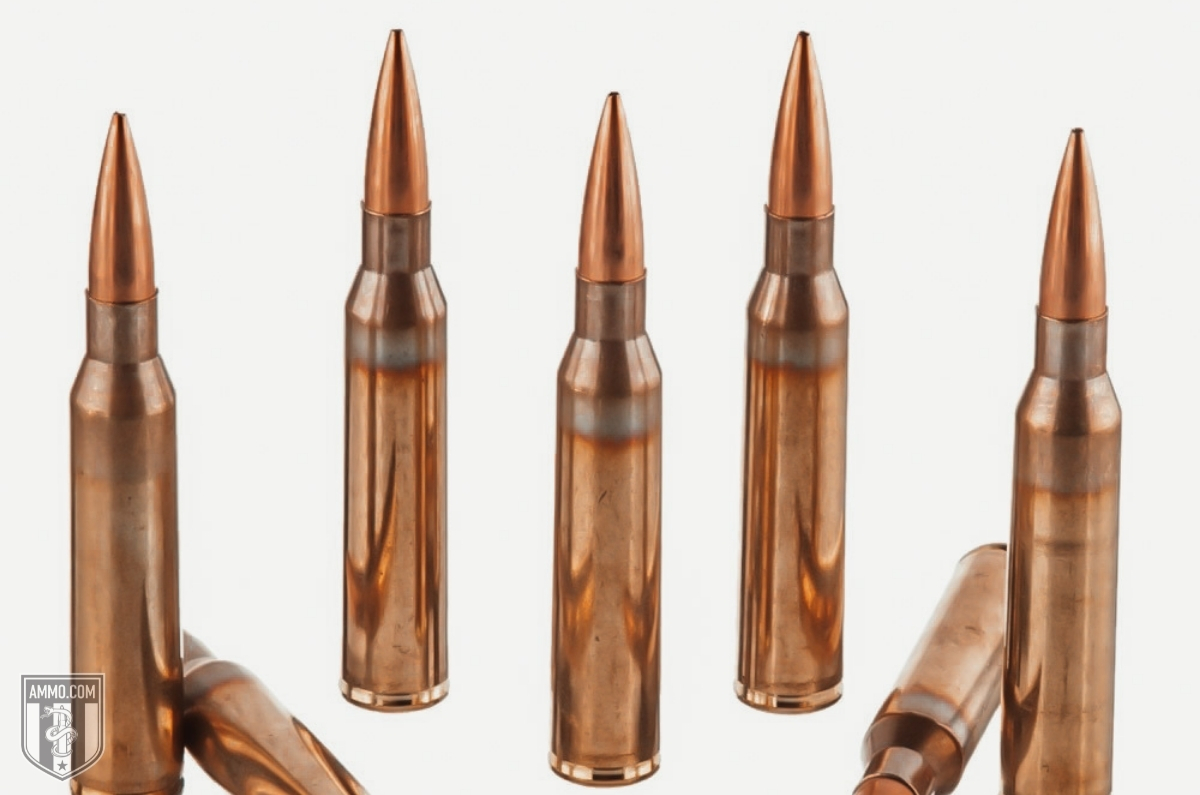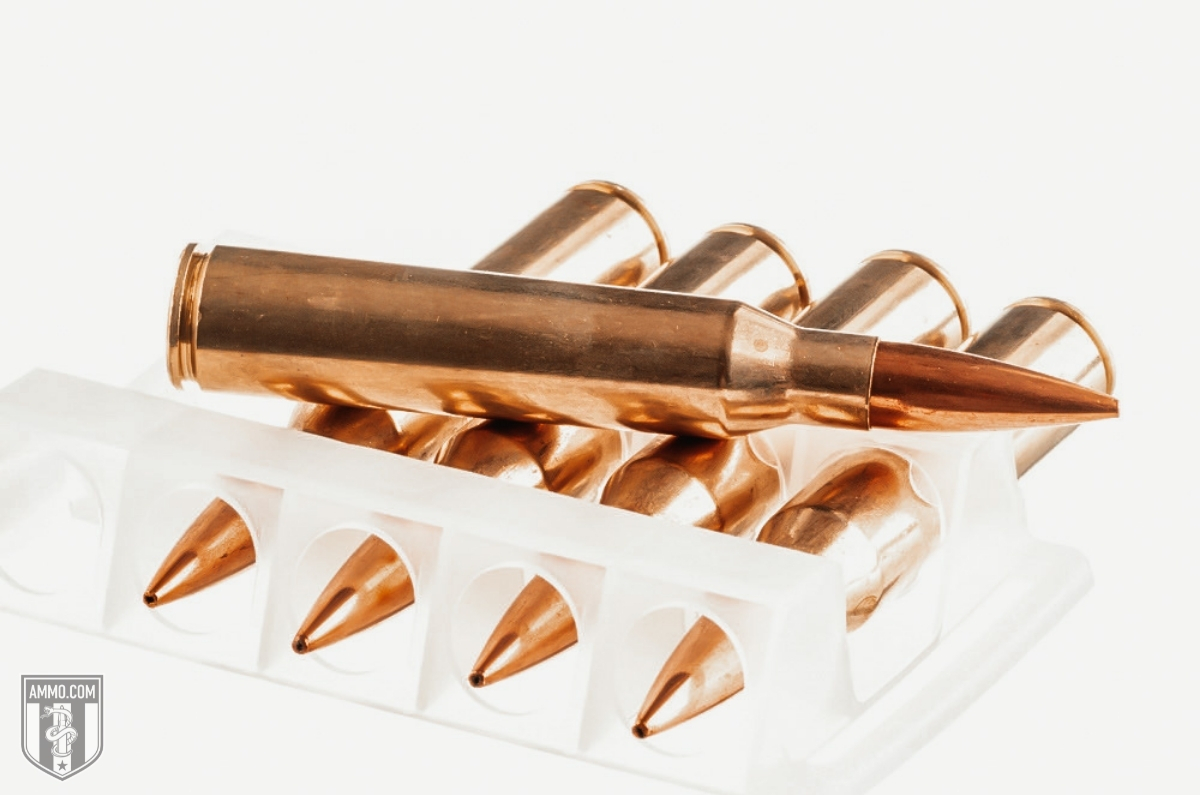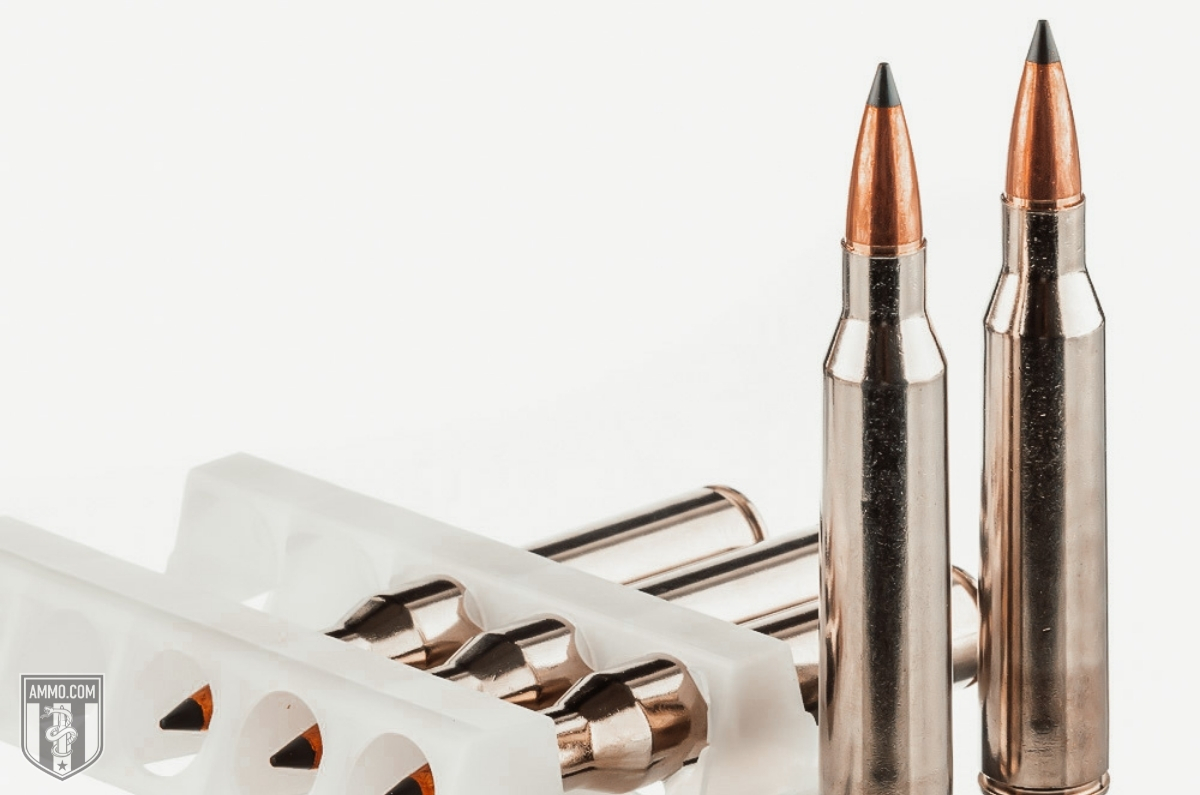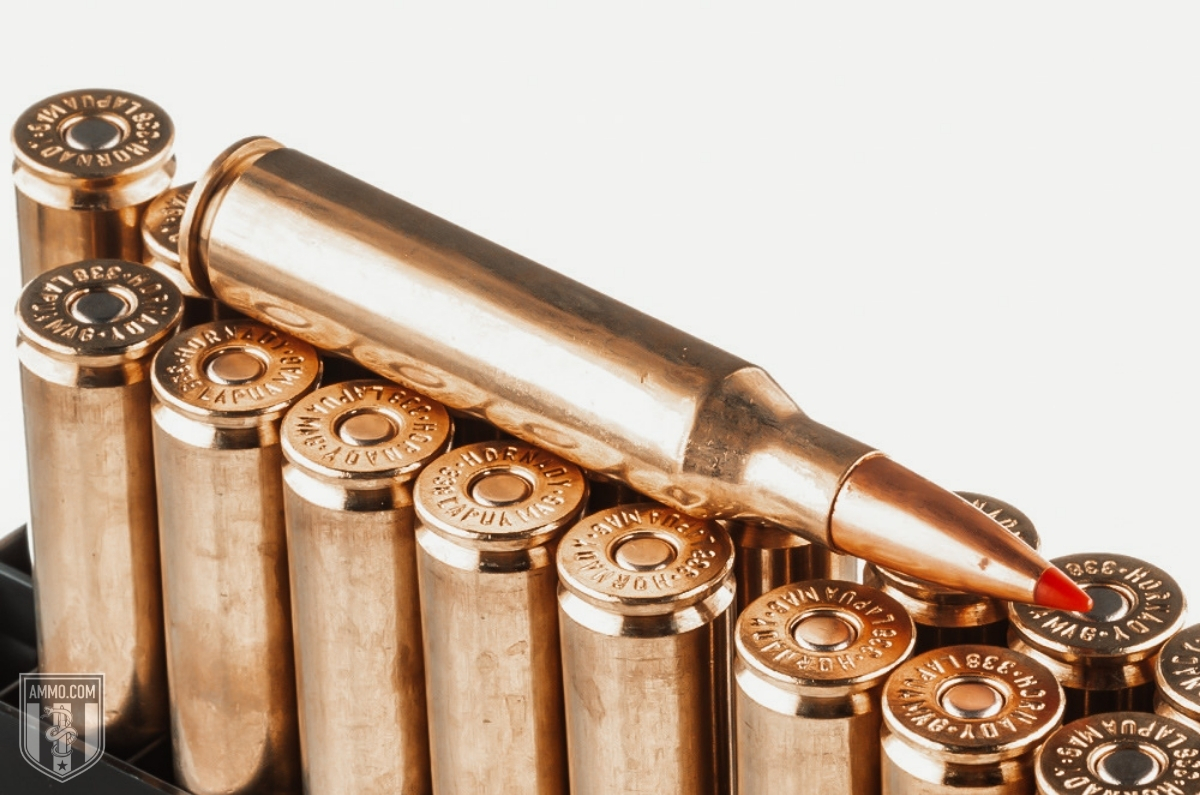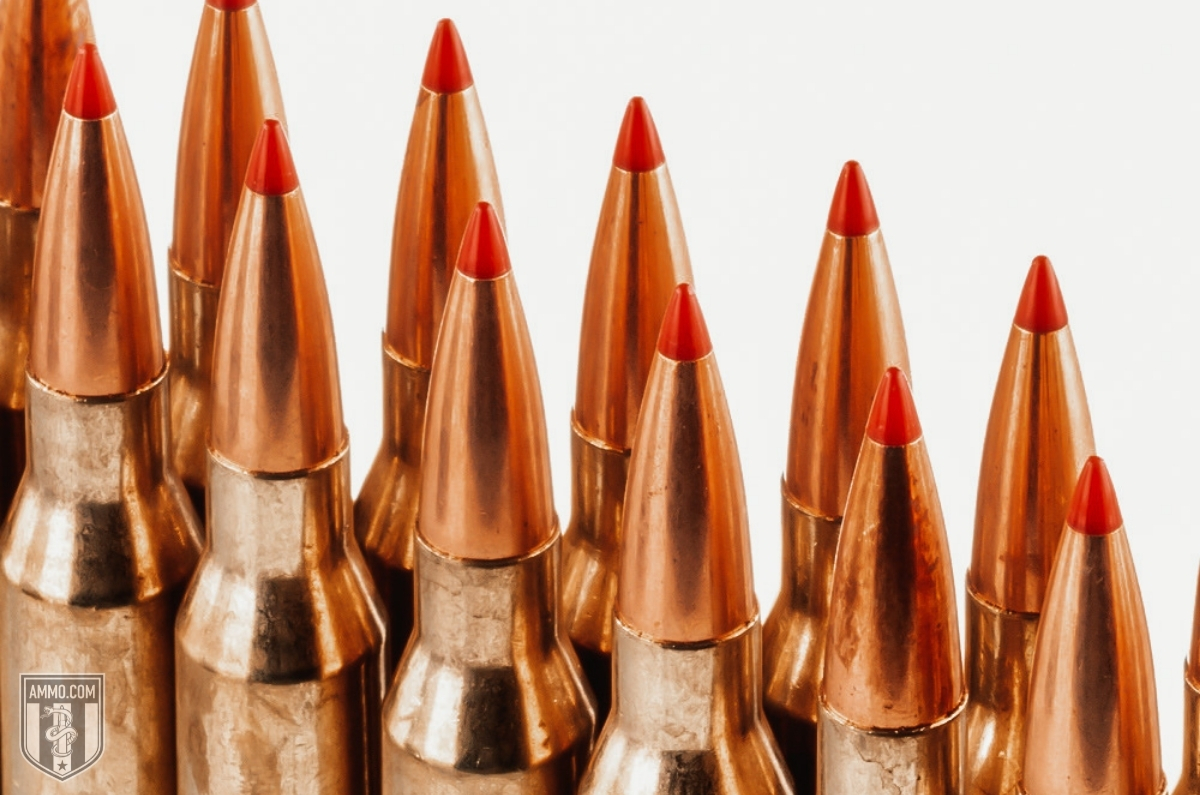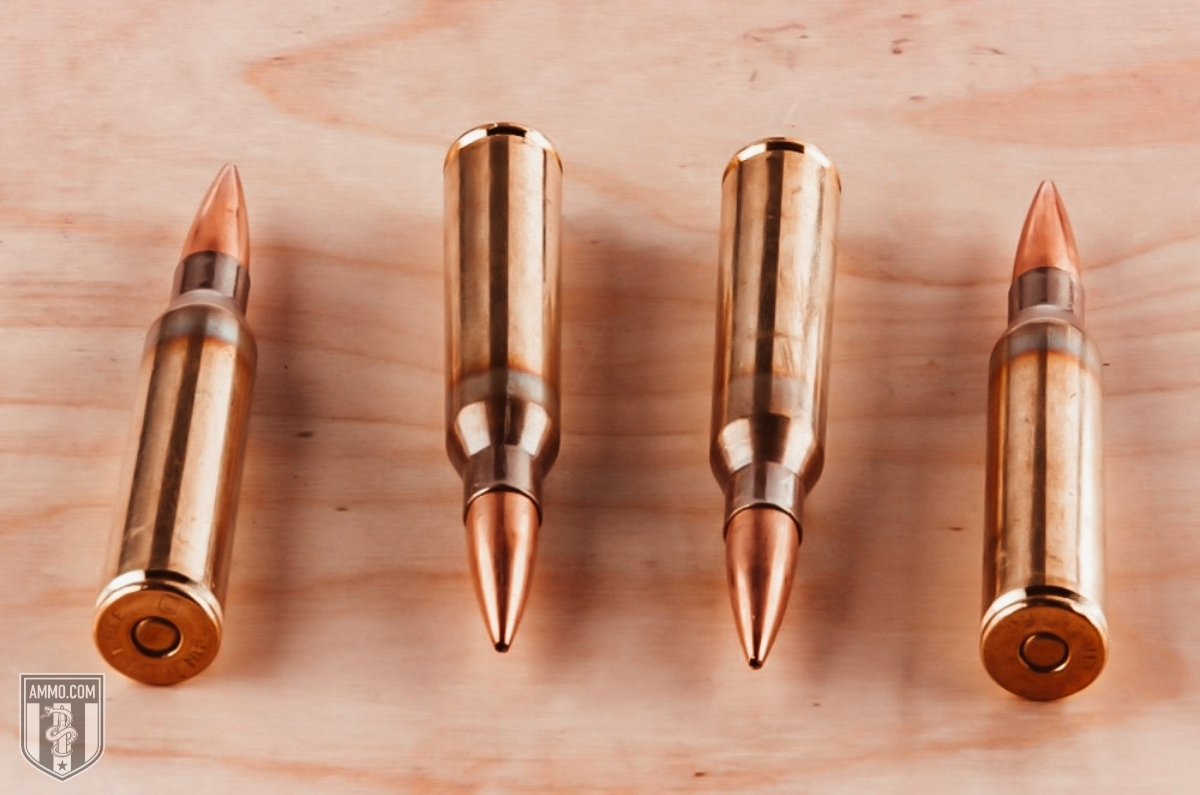.338 Lapua vs .308: A Long Range Shooting Showdown
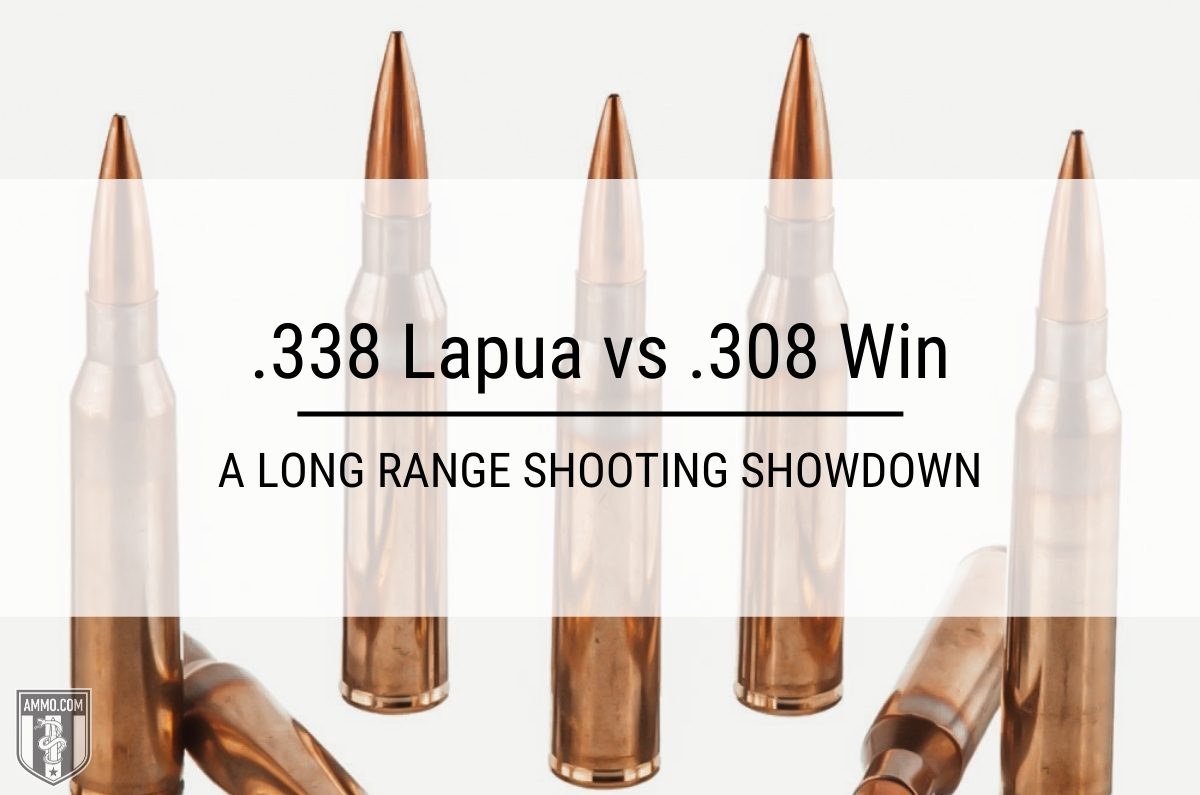 Many big game hunters and long range shooters have battled over which rifle cartridge to buy for their next hunting rifle. More often than not, the 338 Lapua Magnum and 308 Winchester come up in the discussion.
Many big game hunters and long range shooters have battled over which rifle cartridge to buy for their next hunting rifle. More often than not, the 338 Lapua Magnum and 308 Winchester come up in the discussion.
So, if you like long range shooting, and I really mean LONG range, then it’s high time we pulled the trigger on these two sniper rifle staples.
Get out the sandbags, bullet drop charts, and your best spotting scope for this one because we are squeezing the trigger on .338 Lapua Magnum vs .308 Winchester right now!
.338 Lapua Magnum: Little Brother to the 50 BMG
Development of the .338 Lapua Mag began in 1983 by US-based company, Research Armament Industries (RAI). Their goal was to create a cartridge that bridged the gap between the 308/300 Winchester Mag and the 50 BMG.
The design specification required that the cartridge be able to penetrate 5 layers of military-grade body armor at 1000 meters and fire a 0.338” bullet for its ideal sectional density and ballistic coefficient. The targeted muzzle velocity to achieve this requirement was 3,000 fps.
Initial designs for the 338 Lapua Mag utilized the 416 Rigby as a parent case, simply necking it down to accept a 250 grain Hornady A-MAX bullet. Sadly, the 416 Rigby case was not strong enough to withstand the pressures needed to achieve RAI’s ballistic goals.
For reference, the 416 Rigby was designed in 1911 to use cordite as a propellant, not smokeless powder. As such, the Rigby case walls simply could not withstand the pressures the new RAI cartridge needed and the first few batches of the new 338 ammo failed miserably.
At this point, RAI was under pressure from the military to finish their work, so they desperately reached out to the Finnish company, Lapua, in 1984. Straddled with debt, RAI had to drop out of the program, leaving the fate of the new cartridge in the hands of the engineers at Lapua.
The ballistics team at Lapua joined forces with Sako and Accuracy International to work on redesigning the 416/338 cases into something that could handle close to 60,000 psi of pressure.
At first, the case web and walls were thickened, which helped somewhat. However, the real innovation by Lapua came in the form of hardness distribution (hard to soft) from the cartridge face to the mouth.
The final product was an extremely pressure resistant case that was able to achieve velocities just short of the initial 3,000 fps goal. Lapua also moved away from using Hornady bullets, instead utilizing a new bullet of their design, the LockBase B408 fmj.
The finalized .338 Lapua Magnum cartridge was submitted and accepted by the CIP (the European version of SAAMI) in 1989 and became a NATO cartridge shortly thereafter.
NATO standard 338 Lapua Mag ammo fires a 250 grain bullet with a muzzle velocity of 3000 fps and muzzle energy of 4892 ft-lbs.
Undoubtedly, the 338 Lapua Magnum has successfully bridged the gap between the 308 Winchester and the 50 BMG and is currently in consideration to be the military’s anti-personnel ammo of choice for long range engagements.
In terms of the longest sniper shots in history, the #3 spot currently belongs to Corporal Craig Harrison of the British Army firing a 338 Lapua Magnum out of his Accuracy International L115A3. Taking down a Taliban insurgent at 2,707 yards in 2009, Harrison held the #1 spot for 3 years until he was overtaken by an unnamed Australian sniper who popped another hostile in Afghanistan using a 50 BMG out of a Barrett M82A1.
I would be remiss if I did not mention American sniper legend, Chris Kyle, who took down a hostile in the Iraq War at 2,100 yards using .338 Lapua Mag. He currently holds the #10 spot on the longest sniper shots in history.
The .338 Lapua Mag can take down every large game animal on the planet, including African elephants, cape buffalo, and rhinoceros with proper shot placement and a heavier caliber backup like a 416 Weatherby Magnum.
Precision rifle shooters who like to air it out to 1,000 yards or more will appreciate the 338’s ability to easily remain supersonic past 1,400 yards and maintain MOA levels of accuracy. The .338 Lapua has a trajectory that would make any 6.5 Creedmoor or 300 Win Mag shooter green with envy and has the terminal ballistics to make every hunter cry tears of joy.
The .338 Lapua Mag is a powerhouse of a round and will be competing with the 50 BMG for years to come.
.308 Winchester: Replacing the Legendary 30-06 Springfield
Following the end of the Korean War, the U.S. Military started developing a replacement for the storied M1 Garand. Although the M1 Garand had served the U.S. Armed Forces valiantly through World War II and Korea, the military wanted a more modern service rifle with select-fire capability and detachable magazines similar to the Stg-44 and AK-47.
The M1 Garand was chambered in the 30-06 Springfield cartridge, 7.62x63mm NATO designation, a round that has been credited with taking down every North American large game animal, including the great bears. Despite its combat effectiveness and lethality, the 30-06 had some downsides that the military was ready to fix.
First off, the 30-06 Springfield required a long action to accommodate the length of the cartridge. A long action is not ideal for fully automatic fire and the military wanted a short action cartridge for its new service rifle.
With advancements in rifle powder technology and case design in the 1950s, the new 7.62x51mm NATO rifle round was able to achieve neatly identical ballistic performance as the 30-06 Springfield with a shorter cartridge case length (51mm vs 63mm) and lower overall cartridge weight.
The US Army officially adopted the 7.62x51mm NATO round in 1954 and the new M14 battle rifle in 1958. The M14 featured a 20-round detachable magazine and select fire capability (semi-auto and full auto).
The M14 saw its first action in the Vietnam War before being quickly replaced by the M16 and .223 Rem cartridge in 1964.
The 762 NATO round has also been utilized in multiple machine guns fielded by the U.S. Military, including “The Pig” M60, the M240B, and the GAU-17/A minigun. Furthermore, the 762 NATO has been the de facto sniper round for law enforcement, designated marksmen, and military snipers since its adoption.
Seeing the potential of the 762 NATO in the civilian market, Winchester was quick to adapt the new rifle round to its Model 70 bolt action rifle. The civilian version of the 7.62 NATO was named the .308 Winchester and was released to the general public in 1952, two full years before the U.S. Military formally adopted the cartridge.
The .308 Winchester was almost an immediate commercial success for its astounding accuracy, stopping power, and effective range out to 1,000 yards (with appropriate loadings). Since the 1950s and even up to this day, the .308 Win has been a staple in deer hunting camps and in marksmanship competitions across the globe.
One of the appeals of the .308 Winchester for big game hunting is its versatility in bullet weight, typically ranging between 120 to 180 grains.
Although the 6.5 Creedmoor and the 300 Winchester Magnum are becoming more popular in the hunting and precision shooting circles, there is no shortage of shooters who swear by and will never let go of their beloved 308 Winchester.
The Difference Between .338 Lapua vs .308 Winchester: 50 BMG Lite vs .30-06 Slayer
The .338 Lapua Magnum was designed to offer our snipers and marksmen a middle ground anti-personnel round between the 50 BMG and the .308 Winchester.
The .308 was designed as a front line cartridge that found its home in the sniping and light machine gun community.
Both cartridges fulfill specific roles, but how do they compare head-to-head? Let’s find out!
.338 Lapua vs .308: Cartridge Specs
Let’s start our cartridge comparison by looking at the cartridge specifications chart.
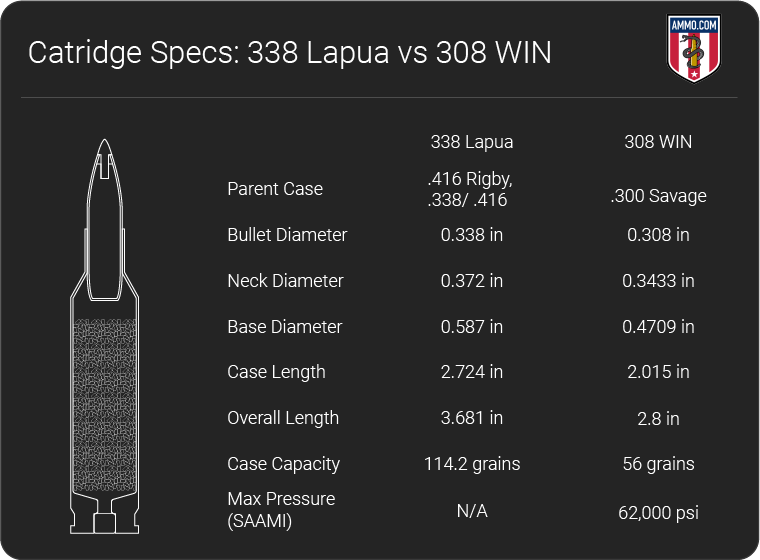
The first thing to note is the massive size difference between the two rifle cartridges. The .338 Lapua simply dwarfs the .308 in overall length by almost a full inch.
This size difference is matched by the case capacity. The .308 Winchester looks like a pretty puny round with a case capacity of only 56 gr H20 while the .338 Lapua has a cavernous case capacity of 114.2 gr H2O.
That’s double the case capacity!
All that powder packed into the .338 Lapua can really get those bullets screaming out of the barrel.
One thing I wanted to note was the Max Pressure category as you’ll note the max pressure for 338 is listed as N/A. This does NOT mean that there is no max pressure for the .338 Lapua, there most certainly is.
The reason it is listed as N/A is because SAAMI has not proofed the .338 Lapua at this time. Furthermore, Lapua and the CIP have been somewhat ambivalent about the max pressure for the cartridge.
There is some scholarly debate as to the max pressure for the .338 Lapua, but if you shoot factory ammo all the time this is a moot point. However, if you plan to handload for the .338 then this is a very important number to know.
When handloading for the .338 Lapua Mag, make sure to stay within the loads listed in your reloading manuals.
Speaking of pressure, I feel like my shoulder could use a massage after popping off a few .338 rounds, let’s talk recoil next!
.338 Lapua vs .308: Recoil
Simply put, the difference in recoil between the .338 Lapua Magnum and the .308 Winchester is substantial.
On average, the .308 Winchester will have a modest recoil of about 20 ft-lbs of force. Most shooters will state that this recoil is manageable, and I can attest that it will not bruise your shoulder after a long day at the range shooting 308.
This is NOT the case for .338 Lapua Mag!
Clocking in at an average felt recoil of 40 ft-lbs of kinetic energy, the 338 has DOUBLE the recoil of the 308. My grandfather would describe this as, “Kicking like a mule” and I feel this is a very accurate description.
All of that case capacity and a 250 grain bullet really come back to punish you when it comes to recoil for the 338. I can say from experience, 40 ft-lbs is shoulder bruising territory.
After a full shooting session of absorbing all that savage recoil from a 338, I’d challenge any non-military trained sniper to maintain their trigger discipline. Recoil anticipation and the resulting trigger jerk are real issues when shooting magnum rounds of this magnitude.
Felt recoil can be tamed somewhat with proper shooting form as well as a muzzle brake, but it cannot be eliminated.
In my opinion, a new shooter should not, under any circumstances, start shooting on a .338 Lapua Magnum rifle. It is too much recoil for a new shooter to handle and they need to be warmed up to it (e.g., a 223 Remington or .308 Win, though a .22 LR would be best!)
That much recoil with a new or small framed shooter will spoil them on the experience by about the second or third shot and the last thing we want is to lose a potential 2A supporter!
.338 Lapua vs .308: Accuracy
Accuracy is a tricky category to empirically analyze as there are factors that cannot be calculated. The rifle system being used, barrel life, consistency of ammo, skill of the shooter, and environmental conditions all play a part in accuracy.
All things being equal, both the .308 and the .338 Lapua are extremely accurate within their effective ranges and sub-MOA accuracy is achievable with match-grade ammo, proper optics, and proper execution of the fundamentals of marksmanship.
However, if you want to qualify accuracy, we need to separate this section into two subsections: under 1,000 yards and over 1,000 yards.
For the .308 Winchester, 1,000 yards is pushing the effective limits of the cartridge.
To make it out to 1,000 yards with a .308, you’ll need a well-tuned precision rifle and match-grade handloads tailored to that rifle. I’d recommend using 175 grain Sierra MatchKing bullets as you’ll need the higher ballistic coefficient to make it out this far.
By comparison, the .338 Lapua Magnum is just stretching its legs at 1,000 yards and leisurely waves at the yardage marker as it screams by.
The average supersonic limit for .338 Lapua is approximately 1,500 yards, a full 50% more than the 308.
Here’s how the accuracy breaks down, under 1,000 yards accuracy should be similar between the two cartridges assuming that the shooter and rifle are tuned properly.
Over 1,000 yards, the .338 Lapua Magnum runs away with it as it can maintain supersonic flight out to 1,500+ yards. This means that the .338 Lapua is better suited for longer range shots.
.338 Lapua vs .308: Trajectory
Trajectory is how we quantify a bullet’s flight path to its target measured in bullet drop.
Looking at the .338 Lapua vs .308 Ballistic Table below, we see some interesting results. For the purpose of this comparison, we look at data from the 178 grain match .308 Win and the 250 grain match .338 Lapua.
As we suspected, the increased case capacity afforded by the massive .338 Lapua cartridge case allows for a higher muzzle velocity and flatter trajectory. At 400 yards, the 338 has dropped -18.8” while the 308 has dropped -21.9”.
This might not seem like a lot, but the further out you go, the more pronounced the difference becomes.
It does not mean that the 308 is inaccurate at these ranges, in truth it’s quite the opposite. However, what it does mean is that a shooter will have to adjust their optics considerably more using a .308 when compared to a .338 Lapua.
.338 Lapua vs .308: Ballistic Coefficient
The ballistic coefficient for a given bullet is a measure of how well it resists wind and air resistance. It’s a numeric representation of how aerodynamic a bullet is, a high BC is preferred and means the bullet will buck the wind easier.
Generally, a heavier bullet will have a higher BC.
With that in mind, it should not be a big surprise to you that the .338 Lapua generally has a higher BC than the 308, and this was done by design.
On average, the .338 Lapua has a BC around 0.62 while the .308 Win has a lower, but still respectable, BC of about 0.43.
This means that the .338 Lapua Magnum will generally resist wind drift and air resistance better than the 308.
.338 Lapua vs .308: Sectional Density
Sectional Density (SD) is the measure of how well a bullet penetrates a target. This is extremely important when hunting big game, as you need a bullet that can punch through thick hide, bone, and sinew.
Sectional density is calculated by comparing the bullet weight and the bullet diameter, the higher the number the more effective it will be at penetrating a target. The higher the SD the deeper the bullet will penetrate into the target.
Over several different offerings, the .338 Lapua Magnum has an average SD of 0.34 compared to 0.26 for .308 Winchester.
This means that the 338 will generally penetrate deeper than a .308.
This result is not overly surprising when you look at the difference in the size of each round and why hunters can use .338 Lapua for hunting Cape Buffalo and African Elephants. A .308 would not be the best option for these big game animals.
.338 Lapua vs .308: Hunting
The .308 Winchester has been the most popular hunting cartridge in North America since its release in 1952. It has been a staple in deer hunting camps and long range target shooting competitions and has only recently been challenged by the 6.5 Creedmoor and the .300 Win Mag.
Its downrange terminal ballistics are decimating to large game and different varieties of hunting bullets and bullet weights are available to tailor your cartridge to the intended game.
But can the .338 Lapua Magnum make its mark in the hunting realm and unseat the 308 as the premier big game hunting cartridge?
In North America, I’m going to go out on a limb and say “No” for anything smaller than a black bear.
For these game animals, the .338 Lapua Mag is simply too much bullet for this type of hunting.
For most North American hunters, shots are typically taken at 400 yards or less. Taking a look at the Ballistics Tables, we see that a 180 grain bullet, a popular hunting round, still retains 1,200 ft-lbs of energy at 400 yards, more than enough to ethically harvest a whitetail.
If you’re loading up for brown bear or Kodiac bear, then I would agree that a heavier, harder hitting bullet like the Nosler 250 grain Partition will be a better choice as you need the additional penetration and kinetic energy for these big game animals.
Furthermore, if you are going on safari in Africa and plan to hunt the Big 5 (lion, leopard, rhinoceros, cape buffalo, and elephant), then a .338 Lapua will get the job done and is one of the accepted calibers to do so.
But anything smaller than the great bears and the African Big 5 is inappropriate for the .338 Lapua Magnum as you can get the same results for much less cost per round using the .308 Winchester.
.338 Lapua vs .308: Ammo Price and Availability
When considering your big game hunting or target shooting rifle, ammo cost should be a consideration. More practice means better accuracy and more consistent results downrange.
The .308 Winchester is by far the better choice when it comes to ammo cost. At the time of writing, you can easily acquire .308 fmj practice ammo for a little below $1/round. While premium .308 Win hunting ammo can be had for about $1.50/round.
Buying in bulk is always smart, make sure to check out our stock of bulk 308 ammo.
This is not the case when it comes to .338 Lapua Magnum. If you’re planning on shooting 338, I do hope that you have a sizable ammo budget because you’re going to need it!
The absolute cheapest .338 Lapua fmj practice ammo that I could find on the Internet was checking in at about $4.45/round (and you had to buy a 200 round case to get this reduced price).
Now let’s consider a 50 round practice session at the range. Shooting .308 Winchester, it will only cost you about $50 in ammo as compared to $220 for shooting .338 Lapua Mag.
That’s a 4x difference!
And it only gets worse when you get into premium .338 Lapua hunting ammo, this will on average run you no less than $8/round with match-grade options in the $10/round realm.
There’s no denying that every time you squeeze the trigger on a .338 Lapua Mag, you hear the “cha-ching” of the cash register instead of the report from the rifle!
Furthermore, there are considerably more ammo options for .308 Winchester than .338 Lapua. The .308 was turning 30 years old when the .338 was just a glimmer in a Lapua ballistician’s eyes.
As such, much more research and development have been applied to the .308 and there are a wide variety of bullet weights and bullet profiles to choose from.
Conversely, the .338 Lapua is a big magnum round and the material cost to produce them is greater than for the .308.
Furthermore, as the .338 Lapua Mag is mostly considered a military cartridge and innovations are focused on that type of shooting, there are fewer options available for hunting as fewer hunters use the round.
.308 is clearly the better option for ammo availability and overall cost.
.338 Lapua vs .308: Rifle Availability
Here’s another category where the .308 Winchester really runs away with it, and the reason is the same as it was for the previous section (its age).
The .308 has been around for over 60 years at this point. Every major rifle manufacturer has a .308 Winchester offering at this point.
You can pick your perfect, factory-built precision rifle with all the custom bells and whistles from manufactures like Savage, Remington, Ruger, Weatherby, and Sako.
Furthermore, there are even budget friendly options like the Savage Axis and the Ruger American when you are in the market for a .308 Win.
You’ve got semi-auto .308 Winchester options as well; such as an AR-10, Springfield M1a, FN-FAL, CETME, and Kel-Tec RFB.
You can even find military surplus bolt action rifles, like a Mauser, that have been re-barreled to shoot .308 Winchester.
Honestly, the sky is the limit when it comes to finding a rifle chambered in .308 Winchester.
For a .338 Lapua Magnum, you need to be ready to drop some serious coin on a new rifle as there are fewer options available. The terms “budget” and “338 Lapua” typically do not live in the same sentence.
Barrett, Sako, Remington, Savage, and Ruger have options available in 338, but do not expect to drop anything less than a grand on a .338 Lapua bolt action rifle. A semi-auto will be even more expensive, you can expect to pay $6,000 or more.
.338 Lapua vs .308: Reloading
If you like to reload as I do, then you’ll have no problem reloading for either of these centerfire rifle cartridges.
The .308 Win has about every conceivable powder and bullet profile available at its disposal, making it one of the most versatile rifle rounds you can reload for.
You’ve got bullet manufacturers like Barnes, Hornady, Sierra, Speer, and Federal all offering different bullet types, profiles, and weights for you to really tailor your perfect .308 loading.
For .338, your options are limited as the cartridge is younger. However, if you want to get your cost per round lower, reloading is the way to do it.
Handloading for the .338 Lapua also allows you to adjust the felt recoil a bit because you can load your practice rounds with a bit lower of a powder charge than your “business” ammo.
Combined with a muzzle brake, reloading is the other way to reduce the 338’s punishing recoil.
Your individual cost per round will vary based on the components you decide to reload with, but I can promise that your cost per round will be below $3/round if you are buying in bulk and shooting fmj bullets.
I would recommend buying powder in bulk for .338, as that black hole of case capacity is going to require a lot of powder to fill!
.338 Lapua vs .308: Ballistics Chart
Our awesome team here at Ammo.com has made some spectacular ballistics tables for you to really dig into the numbers on 338 Lapua vs 308 Winchester. Let’s take a look!
.338 Lapua Ballistics
Note: This information comes from the manufacturer and is for informational purposes only. The actual ballistics obtained with your firearm can vary considerably from the advertised ballistics. Also, ballistics can vary from lot to lot with the same brand and type load.
| 338 Lapua Magnum Bullet WEIGHT | Muzzle VELOCITY (fps) | Muzzle ENERGY (ft. lbs.) | TRAJECTORY (in.) | |||||||||||
|---|---|---|---|---|---|---|---|---|---|---|---|---|---|---|
| Muzzle | 100 yds. | 200 yds. | 300 yds. | 400 yds. | Muzzle | 100 yds. | 200 yds. | 300 yds. | 400 yds. | 100 yds. | 200 yds. | 300 yds. | 400 yds. | |
| 250 Grain | 2900 | 2685 | 2481 | 2285 | 2098 | 4668 | 4002 | 2416 | 2899 | 2444 | 1.7 | 0 | -7.3 | -21.3 |
| 250 Grain | 2963 | 2795 | 2640 | 2493 | n/a | 4842 | 4341 | 3881 | 3458 | n/a | 1.9 | 0 | -7.9 | 0 |
| 250 Grain Match | 2900 | 2760 | 2625 | 2494 | 2366 | 4668 | 4229 | 3825 | 3452 | 3108 | 1.5 | 0 | -6.6 | -18.8 |
| 285 Grain | 2745 | 2616 | 2491 | 2369 | 2251 | 4768 | 4331 | 3926 | 3552 | 3206 | 1.8 | 0 | -7.4 | -21 |
| 285 Grain Match | 2745 | 2623 | 2504 | 2388 | 2275 | 4768 | 4352 | 3966 | 3608 | 3275 | 1.8 | 0 | -7.3 | -20.8 |
| 300 Grain | 2660 | 2544 | 2432 | 2322 | n/a | 4715 | 4313 | 3940 | 3592 | n/a | 1.9 | 0 | -7.8 | n/a |
.308 Ballistics
Note: This information comes from the manufacturer and is for informational purposes only. The actual ballistics obtained with your firearm can vary considerably from the advertised ballistics. Also, ballistics can vary from lot to lot with the same brand and type load.
| 308 Winchester Bullet WEIGHT | Muzzle VELOCITY (fps) | Muzzle ENERGY (ft. lbs.) | TRAJECTORY (in.) | |||||||||||
|---|---|---|---|---|---|---|---|---|---|---|---|---|---|---|
| Muzzle | 100 yds. | 200 yds. | 300 yds. | 400 yds. | Muzzle | 100 yds. | 200 yds. | 300 yds. | 400 yds. | 100 yds. | 200 yds. | 300 yds. | 400 yds. | |
| 55 Grain | 3770 | 3215 | 2726 | 2286 | 1888 | 1735 | 1262 | 907 | 638 | 435 | -2 | 1.4 | -3.8 | -15.8 |
| 110 Grain | 3165 | 2830 | 2520 | 2230 | 1960 | 2447 | 1956 | 1551 | 1215 | 938 | 1.4 | 0 | -6.9 | -20.9 |
| 120 Grain | 2850 | 2497 | 2171 | n/a | n/a | 2164 | 1662 | 1256 | n/a | n/a | 0 | -2.8 | n/a | n/a |
| 150 Grain | 2820 | 2533 | 2263 | 2009 | 1774 | 2648 | 2137 | 1705 | 1344 | 1048 | 2.5 | 0.4 | -8.5 | -26.1 |
| 150 Grain Superformance | 3000 | 2772 | 2555 | 2348 | 1962 | 2997 | 2558 | 2173 | 1836 | 1540 | 1.5 | 0 | -6.9 | -20 |
| 155 Grain | 2775 | 2553 | 2342 | 2141 | 1950 | 2650 | 2243 | 1887 | 1577 | 1308 | 1.9 | 0 | -8.3 | -24.2 |
| 155 Grain | 2850 | 2640 | 2438 | 2247 | 2064 | 2795 | 2398 | 2047 | 1737 | 1466 | 1.8 | 0 | -7.5 | -22.1 |
| 165 Grain | 2700 | 2440 | 2194 | 1963 | 1748 | 2670 | 2180 | 1763 | 1411 | 1199 | 2.5 | 0 | -9.7 | -28.5 |
| 168 Grain | 2680 | 2493 | 2314 | 2143 | 1979 | 2678 | 2318 | 1998 | 1713 | 1460 | 2.5 | 0 | -8.9 | -25.3 |
| 168 Grain Super Match | 2870 | 2647 | 2462 | 2284 | 2114 | 3008 | 2613 | 2261 | 1946 | 1667 | 1.7 | 0 | -7.5 | -21.6 |
| 170 Grain | 2000 | 1740 | 1510 | n/a | n/a | 1510 | 1145 | 860 | n/a | n/a | 0 | 0 | 0 | 0 |
| 178 Grain | 2620 | 2415 | 2220 | 2034 | 1857 | 2713 | 2306 | 1948 | 1635 | 1363 | 2.5 | 0 | -9.6 | -27.6 |
| 178 Grain Super Match | 2780 | 2609 | 2444 | 2285 | 2132 | 3054 | 2690 | 2361 | 2064 | 1797 | 1.8 | 0 | -7.6 | -21.9 |
| 180 Grain | 2620 | 2393 | 2178 | 1974 | 1782 | 2743 | 2288 | 1896 | 1557 | 1269 | 2.5 | -0.2 | -10.2 | -28.5 |
One topic that we did not discuss is the ridiculous amount of muzzle energy the .338 Lapua produces.
At the muzzle, you are looking at a bone-breaking 4,668 ft-lbs of kinetic energy on the low end. The high end for .308 Win is about 3,000 ft-lbs of energy…that’s a 50% increase for the .338 Lapua Mag.
Furthermore, kinetic energy is conserved and bleeds off slower for the .338 Lapua compared to the 308. This is attributed to the higher ballistic coefficient bullets that the .338 fires and the higher muzzle velocity as the .338 will simply get to the target faster than a .308.
.338 Lapua vs .308: Conclusions
There’s no denying the sheer power that the .338 Lapua Magnum commands. It’s a punishing, deadly, powerful round that can punch through body armor at 1,000 yards like a hot knife through butter.
It remains lethal well beyond 2,000 yards as Corporal Craig Harrison proved in 2009 while serving in Afghanistan. To put it bluntly, a .308 Winchester is not capable of that fired from a rifle (fired from an AC-130 is a different story).
But does that mean that the .308 Winchester is anemic, inaccurate, and obsolete?
Absolutely NOT!
The .308 Win offers excellent ballistics in a smaller, less expensive, and lower recoiling package that has been proven as combat and hunting effective for over half a century.
It is still the choice of many police department marksmen and military snipers.
The .308 Win is likely the better choice for almost every hunter in North America, due to rifle availability, rifle cost, ammo cost, and lower recoil.
The truth of the matter is that most shooters do not need a .338 Lapua to do what they want, a .308 is more than enough to get the job done.
However, if you’re looking to shoot long range (out past 1,000 yards) and you need that extra power and fps to get you there, the .338 Lapua will not let you down.
Find yourself a shooting range that allows you to practice at that range and I have no doubt that you’ll be on the victor’s podium at your next F-class competition holding your .338 Lapua Magnum.
Ammo Comparisons
- .308 vs 5.56
- 6.5 Creedmoor vs .308
- .300 Blackout vs .308
- .300 Win Mag vs .308
- .243 vs .308
- .308 vs .30-06
- 7mm-08 vs .308
- .270 vs .308
- 7.62x39 vs .308
- .223 vs .308
- .338 Lapua vs .308
- .380 ACP vs 9mm
- .223 vs 5.56
- .300 Blackout vs 5.56
- 9mm vs 45 ACP
- 9mm vs 40 S&W
- .357 SIG vs 9mm
- 10mm vs 9mm
- 9mm vs 9mm Luger
- .243 vs .270
- .300 Win Mag vs .30-06
- .270 vs .30-06
- .40 vs .45
- 38 Special vs 357
- 9mm vs 40 vs 45
- 5.56 vs 7.62x39
- 338 Lapua vs .30-06
- .30-30 vs .30-06
- 300 PRC vs 338 Lapua
- .30-06 vs 7mm
- 300 Win Mag vs 338 Lapua
- 300 PRC vs 300 Win Mag
- 300 WSM vs 300 Win Mag
- 338 Win Mag vs 338 Lapua
- 12 Gauge vs 20 Gauge
- 10mm vs 357 Mag
- .30-30 vs 7.62x39
- 224 Valkyrie vs 22-250
- 17 HMR vs 22 Mag
- 7.62x39 vs .300 Blackout
- 45 ACP vs 45 Auto
- 45-70 vs 30-30
- 300 Blackout vs 223
- 357 Magnum vs 9mm
- 350 Legend vs 300 Blackout
- 224 Valkyrie vs 223
- 45 ACP vs 38 Super
- 6.5 Grendel vs .308
- 17 HMR vs 22 LR
- 10 Gauge vs 12 Gauge
- 22-250 vs 223
- 45 Colt vs 45 ACP
- 350 Legend vs 30-30
- 5.7x28 vs 223
- 5.7 vs 9mm
- 5.56 vs 5.7
- 22 vs 9mm
- Buckshot vs Birdshot
- 450 Bushmaster vs 308
- 450 Bushmaster vs 223
- Buckshot vs Slug
- 6.5 Grendel vs 5.56 vs 223
- 6mm ARC vs 6.5 Grendel
- 44 vs 45
- 458 SOCOM vs 5.56
- 357 vs 44
- 32 ACP vs 380
- 300 Win Mag vs 338 Win Mag vs 338 Lapua Mag
- 450 Bushmaster vs 458 SOCOM vs 50 Beowulf
- 6mm Creedmoor vs 6.5 Creedmoor
- TMJ vs FMJ
- 44 Special Vs 44 Magnum
- 45 90 vs 45 70
- 6.8 Western vs 6.8 SPC
- 50 Beowulf vs 50 BMG
- 26 Nosler vs 6.5 PRC
- 28 Gauge vs 410
- 6.8 SPC vs 5.56
- 6.8 SPC vs 6.5 Grendel
- 6.8 Western vs 7mm Rem Mag vs .28 Nosler
- 6.8 Western vs 6.5 Creedmoor
- 22 Hornet vs 223
- 6.8 Western vs 6.5 PRC
- .410 vs 12 Gauge
- .410 vs 20 Gauge
- 22 LR vs 22 Mag
- 6mm ARC vs 243
- 7mm-08 vs 270
- 243 vs 6.5 Creedmoor
- Nickel vs Brass Casing
- 204 Ruger vs 223
- 50 Beowulf vs 5.56
- 260 Remington vs 6.5 Creedmoor
- 6mm Remington vs 243
- 28 Nosler vs 300 PRC
- 50 Beowulf vs 50 AE
- 22 Nosler vs 22-250
- 450 Marlin vs 45-70
- 300 Win Mag vs 300 Norma
- 458 SOCOM vs 300 Blackout
- 38-55 vs 45-70
- 22 Hornet vs 22 LR
- 300 Norma vs 338 Lapua
- 338 Lapua vs 50 BMG
- 28 Nosler vs 300 Win Mag
- 28 Nosler vs 6.5 Creedmoor
- 204 vs 22-250
- 458 SOCOM vs 45 70
- 44 40 vs 45 70
- 6.8 SPC vs 6.5 Creedmoor
- 450 Bushmaster vs 30-06
- 7mm Rem Mag vs 300 Win Mag
- 30 Carbine vs 223
- 25-06 vs 30-06
- 26 Nosler vs 28 Nosler
- 16ga vs 12ga
- 30 06 vs 7.62 x54R
- 9mm Makarov vs 9mm Luger
- 350 Legend vs 223
- 30 Carbine vs 5.56
- 6.5x55 vs 6.5 Creedmoor
- 6.5 Creedmoor vs 270 vs 25-06
- M193 vs M855
- 450 Bushmaster vs 458 SOCOM
- 6.5 Grendel vs 6.5 Creedmoor
- 350 Legend vs 5.56
- .277 Fury vs 6.8 SPC
- 277 Fury vs 300 Win Mag
- 10mm vs .45 ACP
- 277 Fury vs 223
- 6.8 SPC vs 300 Blackout
- 6.5 PRC vs 6.5 Creedmoor
- 277 Fury vs 308
- 277 Fury vs 6.5 Creedmoor
- 350 Legend vs 450 Bushmaster
- 277 Fury Vs 5.56 NATO
- 10mm vs 40S&W
- 32 ACP vs 9mm
- 32 Special vs 9mm
- 8.6 Blackout vs 300 Blackout
- 30 Super Carry vs. 9mm
- 5.56 vs 9mm
- .50 Action Express vs 9mm
- 7.62x25 vs. 9mm
- 10mm vs 44 Magnum
- 300 Blackout vs 300 Win Mag
- 6.5 Grendel vs 300 Blackout
- 460 Rowland vs 10mm
- 300 RUM vs 300 PRC
- 300 Norma vs 300 PRC
- 45 GAP vs 45 ACP
- 7mm PRC vs 300 Win Mag
- 300 PRC vs 6.5 Creedmoor
- 300 PRC vs 308
- 357 SIG vs 357 Mag
- 7.62x39 vs 7.62x51
- 243 Win vs 223 Rem
- 30 Nosler vs 300 PRC
- 6.5 Creedmoor vs. 30-06 Springfield
- 450 S&W vs. 44 Magnum
- 6.5 Creedmoor vs. 300 Win Mag
- 454 Cassull vs. 45-70 Govt
- 454 Cassull vs. 44 Mag
- 7.62x54r vs. 308 Winchester
- 22 ARC vs. 223 Rem
- Subsonic vs. Supersonic Ammo
